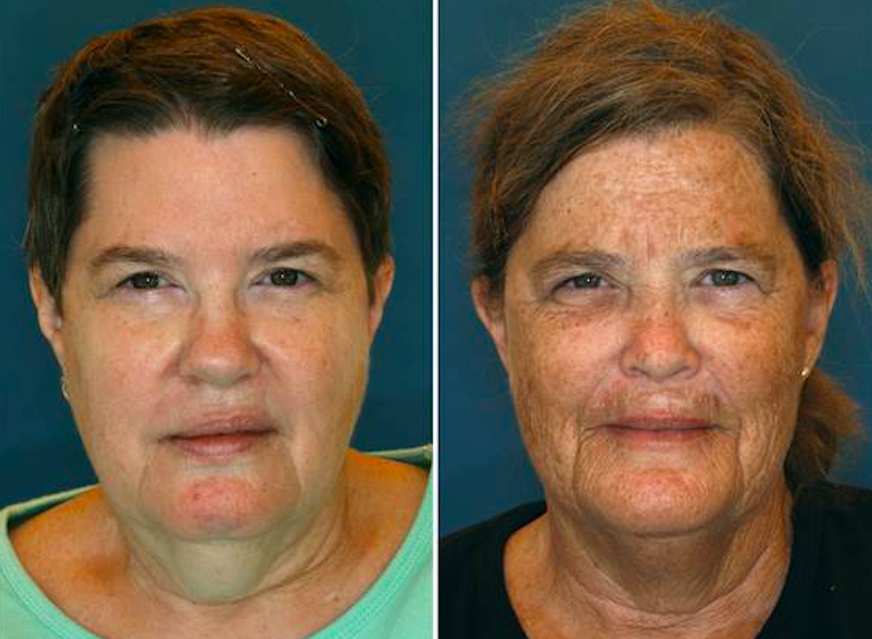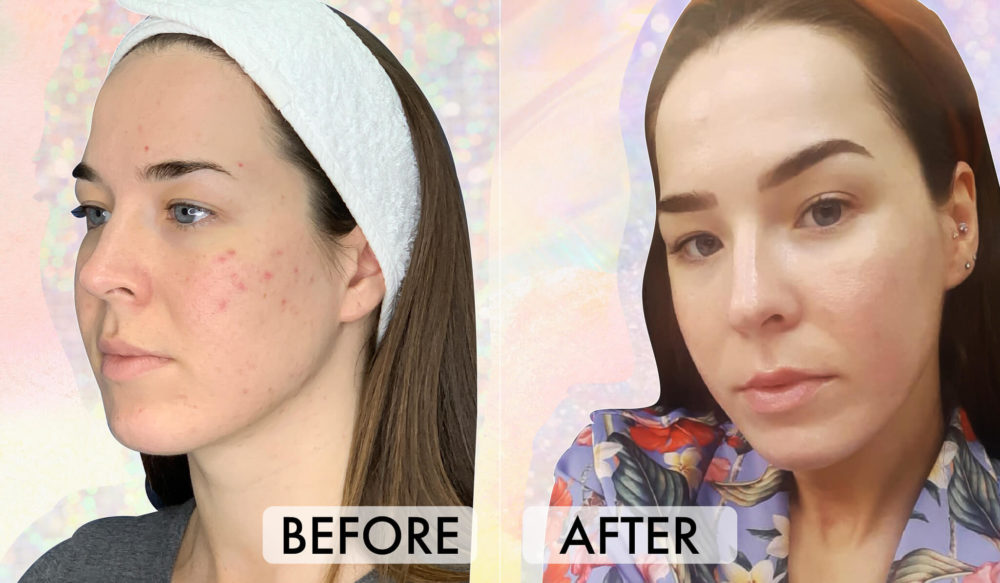If You Believe These SPF Myths, You're In BIG Trouble

Source: Victoria 1/Shutterstock
If there’s one product you NEED to use every day for happy and healthy skin, it’s sunblock. It’s actually crazy that 90% of how your skin ages is completely within your control and it’s directly related to sun exposure. Most of us think we only need to wear sunscreen to stop our skin from burning, so we only apply it when we’re tanning or on vacay – this is NOT true. The New England Journal of Medicine recently published this portrait of a 69-year-old truck driver, which due to the nature of his job, meant that only one side of his face was consistently exposed to the sun. The difference is dramatic, and it shows just how strong the impact of the sun can be.
Source: The New England Journal of Medicine
His 28 years of being a truck driver (and not wearing sunscreen) meant that only one side of his face was exposed to the UVA rays that transmitted through the truck window – the damage is shown in skin thickening, deep wrinkles, and sagging skin to his left side. This demonstrates exactly how your skin could age with and without sunblock. If this isn’t enough to make you want to start wearing sunblock regularly, we’re not sure what will.
So, because there’re so many myths around using suncream, and because it’s SO important to use it correctly, we got together with Dr. Friedmann from the London Dermatology Clinic, one of the leading dermatology centers in the world, for his advice. Here’s the full DL on how you need to use sunblock and what to look for.
How does sunblock work?
By using sunblock, you’ll be able to better protect your skin from the powerful UV rays of the sun. What a lot of people don’t realize, is there are two types of UV rays, UVA and UVB, and you need to make sure you’re protected from both. Here’s how they differ:
UVB: UVB rays are directly responsible for sunburn, skin discoloration, redness, and UVB radiation, and they also contribute to skin cancer. SPF (sun protection factor) helps you block the UVB rays, and the higher the SPF, the stronger the protection will be. Friedmann explained that in general “an SPF 50 means for every 50 minutes in the sun, you’ll get the equivalent of one-minute unprotected sun exposure.”
UVA: UVA rays are considered more dangerous than UVB as they penetrate more deeply, although when you’re in the sun you can’t actually feel them burning your skin. It’s these rays that are the main cause of long-term skin damage, like fine lines and wrinkles and the destruction of collagen that leads to skin sagging – it also causes certain types of skin cancer. UVA rays are the dominant tanning ray (even when you’re in a tanning booth), and can pass through glass and clouds. So, when you look for sun protection make sure it has a 4-5 star UVA rating because SPF doesn’t protect you from UVA rays.

Dr. Friedmann recommends that you should always use “SPF 30 as a minimum”, with “at least a 4-star UVA rating.” He also says “a dermatologist will always advise a higher factor such as SPF 50 with UVA blockers.”
How should you apply sunblock?

via Giphy
On a daily basis…
Whether you’re going to the beach or you just have to commute to work, you should apply sunscreen to your face, ears, and neck every morning. When you’re spending the entire day in the sun, Dr. Friedmann told us you should, “reapply your sunscreen every two hours as a minimum, as you normally apply a lot less than is done during lab testing – which means an SPF 30 will sometimes only offer you SPF 15.” This is why a lot of people get sunburnt even when they’re protected, as their sunscreen is only having half the impact it could. So not only do you need to top up every two hours but he also recommends you should “apply a finger-sized squirt for an area of the skin the size of your hand,” to ensure you’re using enough product.
Use sunblock before going in the sun…
You should always apply sunblock 20 minutes before you expose your skin to the sun, as it takes that amount of time for it to be absorbed.
Don’t just rely on your foundation…
Dr. Friedmann appreciates that “a lot of foundations, moisturizers, and primers contain at least SPF15, which is probably enough protection during the winter months”. However, in the summer, always accompany your cake face with a high SPF sunscreen. SPF works as a protective barrier, so you should always apply it after your moisturizer.
Sunblock expires… Like any of your beauty products, over time, they lose their effectiveness. Check the ‘open jar’ symbol, which indicates how long after the product is open that it’s safe to use. The number inside indicates months, so 6M is six months and 12M means 12 months. If your sunblock has been open for longer than the date the symbol indicates is safe, the effectiveness of the SPF will be reduced.
Like any of your beauty products, over time, they lose their effectiveness. Check the ‘open jar’ symbol, which indicates how long after the product is open that it’s safe to use. The number inside indicates months, so 6M is six months and 12M means 12 months. If your sunblock has been open for longer than the date the symbol indicates is safe, the effectiveness of the SPF will be reduced.
Don’t forget to apply it here…
We know it sounds extra af, but you should also use a lip balm containing SPF. Your scalp is another place often forgotten, so it’s always good to have a spray sunscreen and a lotion to mist your hairline.
Posts You'll Love:
Sunblock Myths Debusted:
“The higher the price the better the protection.”
Verdict: NOT TRUE
Dr. Friedmann believes that when it comes to sunscreen, “you don’t have to buy an expensive brand but make sure you choose one that not only has a high SPF (to protect against the burning UVB rays) but one that also has at least a 4-star UVA rating, preferably 5 stars. We know that UVA can cause skin cancer and so sunscreens that protect against UVB only, are not ideal. In fact, because they slow skin burning, they permit people to stay in the sun longer, so they could increase the likelihood of skin cancer later in life, through all the additional UVA exposure.” This is why Dr. Friedmann would opt for the “SunSense Daily Face SPF50+ Invisible Tint Finish Sunscreen, $15, or any of the Nivea sunscreen line that’s targetted for children”, as they provide powerful, long-lasting protection.

via Giphy
“A base tan will help protect you from skin damage”
Verdict: SO NOT TRUE
Going to a tanning salon before your vacation, in order to ‘prep’ your skin for the sun will actually cause more damage than good. A tan is actually a biological and physical signal from the skin that it’s damaged. You should avoid tanning beds at all costs – the World Health Organization has listed them as one of the most dangerous forms of cancer-inducing radiation. The risk of a melanoma is increased by 75% if you use a tanning bed before the age of 30.
“Higher SPF factors contain harmful chemicals that will harm my skin.”
Verdict: NOT TRUE
Some people have been warned against higher factors, as it has been suggested that the chemicals within can cause harm, however, Dr. Friedmann confirms that “the evidence to suggest this is very limited”. Although we would recommend buying mineral-based sunscreens, instead of chemical sunscreens, as they’re not only believed to be harming the world’s coral reefs but Friedmann suggests that the “chemicals used in transparent sprays and mists expire much quicker than mineral-based sunblocks”. Look for formulas that contain zinc and titanium as they’re the best natural ingredients that don’t irritate your skin.
Posts You'll Love:
“You can’t get sunburned through clouds.”
Verdict: SOOO NOT TRUE
Even if it’s a cloudy day, that doesn’t mean you can’t get sunburnt, as 70-80% of UV rays still penetrate through clouds. Experience shows that you’re more likely to get burnt on a cloudy day as you believe the clouds offer protection, so you don’t bother to apply sunblock – always apply sunblock! The sunlight also intensifies when it reflects against snow, sand or water, so be mindful of that.

via Giphy
“Wearing SPF will prevent you from skin damage.”
Verdict: NOT true
Even if you’re religious with your SPF application, you’re still exposing yourself to some UVA and UVB rays that can have an impact over time. This is why it’s really important to check your body regularly for any skin damage, especially at the beginning of summer – before you start to spend time in the sun. The main thing you need to look out for are melanomas, which tend to resemble a mole, that begin to change in size, shape or color. They may become lumpy and may even bleed. Sometimes they occur in a pre-existing mole, but around half the time they occur in an area of normal skin. Here are the changes Dr. Friedmann insists you need to look out for regularly:
- Change in size: The mole looks unusual, asymmetrical or irregular.
- Border: The border becomes blurred, ill-defined or irregular.
- Color: More than 2 colors appear in the mole, including brown, black or light areas giving a mottled appearance. A very dark or black appearance can occur.
- Diameter: If a mole is enlarging it should be reviewed.
If you do notice any of these changes, make sure you get them checked by a dermatologist.
If you’re STILL not convinced how crucial sun protection is for your skin, then check out this case study on the effect of the sun on identical twins:

Source: ScienceDaily
These are twins sisters, both aged 61. Susan on the right not only smokes but likes to spend as much time in the sun as possible (and she lives in Florida, so that’s pretty much the whole year!). Compared to Jeanne, who spends as little time in the sun as possible. Researchers estimated that Susan looked 11 years older, due to her dark spots, deep wrinkles, and sagging skin.
Let us know in the comments below if you’re a big sunscreen fan, or if you’re now going to start using sunblock daily.























Leave a comment